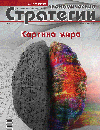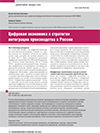Digital Economy in the Strategy of Production Integration in Russia
DOI: 10.33917/es-4.162.2019.18-24
The article formulates conceptual provisions revealing the strategy of production integration in the context of the Russian economy digitalization; the paper justifies the logic of its formation as a socio-economic vector, contributing to creation of the digital economy, ensuring the growth of competitive advantages of Russian enterprises and the economy as a whole; the author reviews foreign experience of the strategy of production integration and integrated structures formation, which should be taken into account in domestic practice; the article analyzes functional strategies of production integration in the Russian economy; the paper substantiates the role of cluster integration, contributing to creation of innovative territorial clusters as a growth factor for the digital economy, which contributes to creating and applying digital technologies, as well as to formation of a new digital platform in the production integration strategy with the aim of improving social and economic situation in the Russian Federation
References:
|
1. Putin: bez tsifrovoi ekonomiki u Rossii net budushchego [Putin: Without Digital Economy Russia has No Future]. Forklog, available at: https://forklog.com/putin-bez-tsifrovoj-ekonomiki-u-rossii-net-budushhego. 2. Rasporyazhenie Pravitel’stva RF ot 28 iyulya 2017 g. N 1632-r “Ob utverzhdenii programmy „Tsifrovaya ekonomika Rossiiskoi Federatsii“ [Resolution № 1632-r of the Russian Government of July 28, 2017 “On Approving the Programme “Digital Economy of the Russian Federation”]. Garant, available at: http://base.garant.ru/71734878/#ixzz4xa7EKLoG. 3. Natsional’nyi proekt “Tsifrovaya ekonomika” [National Project “Digital Economy”]. Vikipediya, available at: https://ru.wikipedia.org/wiki/ 4. Nosova S., et al. Turbulence in the Russian Economy Management System. International Journal of Economics and Financial Issues (IJEFI), 2016, no 6(S1), pp. 233–238. 5. Ansoff I.H. Strategies for Diversification. STPLAN.RU, available at: http://stplan.ru/articles/theory/mansoff.htm. 6. Porter M.E. Competitive Strategy: Techniques for Analyzing Industries and Competitors. N.Y., The Free Press, 1980. 7. Nosova S., et al. Assessing the Role of Nano-intellectual Capital as a Factor in the Growth of High-Tech Industrial Complex of Russia. International Journal of Applied Business and Economic Research, 2017, vol. 15, no 13, pp. 53–62. 8. SWOT-analiz kak instrument strategicheskogo menedzhmenta [SWOT-analysis as a Tool for Strategic Management]. HR-Portal, available at: http://hr-portal.ru/article/ 9. Nosova S.S., еt al. The Strategy of the Digital Transformation of the Russian Economy in the XXI Century. International Journal of Civil Engineering and Technology (IJCIET), 2019, February, vol. 10, issue 02, pp. 1638–1648. 10. Nosova S., et al. Conceptual Approaches to Overcoming Turbulence in the Innovative Development of Russian Industrial Enterprises. International Journal of Applied Business and Economic Research, 2017, vol. 15, no 13, pр. 223–230. 11. Nosova S. The Entrance of Modern Economy of Russia Onto the New Trajectory of Growth. International Journal of Applied Business and Economic Research, 2017, vol. 15, no 13, pp. 73–80. 12. Nosova S.S. Strategiya innovatsionnoi ekonomiki v rezhime kollaboratsii [Innovation Economy Strategy in Collaborative Mode]. Ekonomicheskie strategii, 2018, no 6, pp. 48–57. |



